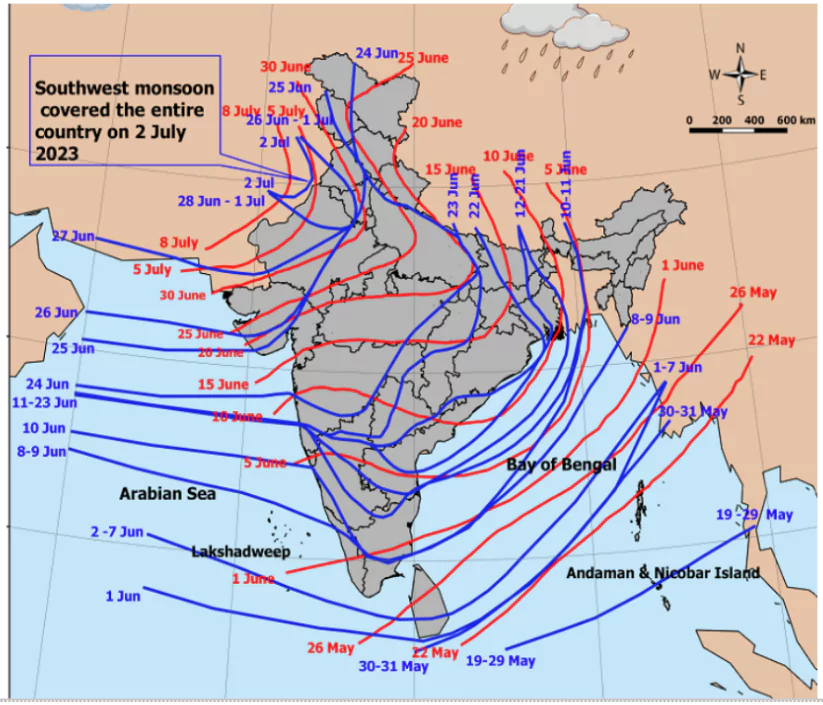Summer in India varies in intensity across different regions, with northern areas experiencing scorching temperatures reaching up to 48°C, while southern parts benefit from milder weather due to coastal influences and higher altitudes. The onset of summer brings about significant changes in weather patterns, including shifts in surface pressure, wind directions, and the occurrence of local storms. Understanding these mechanisms is crucial for comprehending India’s diverse climatic conditions during the hot weather season.
Mechanisms of Weather in Summer Season
A. Temperature Condition
- Northern India: In March it starts getting hotter in North India as the sun moves towards the Tropic of Cancer.
- April, May, and June: hottest months in North India.
- Temperatures range from 30°C to 32°C in most parts of India.
- The heat moves further north in May, with temperatures around 48°C in north-western India.
 Deccan Plateau: The Deccan Plateau sees temperatures as high as 38°C in March, and in April, Gujarat and Madhya Pradesh can reach between 38°C and 43°C.
Deccan Plateau: The Deccan Plateau sees temperatures as high as 38°C in March, and in April, Gujarat and Madhya Pradesh can reach between 38°C and 43°C.- South India: hot season is milder due to its location and ocean influence, with temperatures between 26°C and 32°C.
- Western Ghats:hills stay cooler, below 25°C, due to their altitude.
- Costal Region: Temperatures increase from the coast to the interior.
B. Surface Pressure and Winds
- With the onset of summer and the sun’s northward movement, air pressure drops in the northern half of India. India’s wind circulation sees a reversal at both lower and upper levels.
- Low pressure belt [InterTropical Convergence Zone (ITCZ)] shifts northwards, roughly parallel to the Himalayas between 20° N and 25° N by the middle of July. The ITCZ extends from the Thar desert to Patna and Chotanagpur plateau.
- By this time, the Westerly jet stream withdraws from the North Indian Plain. Northward shift of the equatorial trough (ITCZ) and withdrawal of the westerly jet stream are interrelated.
- ITCZ (low-pressure zone), attracts inflow of winds from different directions; maritime tropical air mass (mT) from the southern hemisphere crosses the equator and moves towards the low-pressure area in a southwesterly direction which results in southwest monsoon.
- Jet Streams and Upper Air Circulation: In June, an easterly jet stream flows over the southern part of the Peninsula.
- Local storms: hot and dry winds called ‘Loo’ blow in the afternoon and sometimes until midnight in the northwest.
- Local storms with violent winds, heavy rains, and even hailstorms can occur due to the contact between dry and moist air masses.
- Dust Storms: Common in May in Punjab, Haryana, Rajasthan, and Uttar Pradesh, bringing relief from the heat with light rains and cool breezes.
Enroll now for UPSC Online Course
Some Famous Local Storms of Hot Weather Season
- Loo: Hot and dry winds blowing in the Northern plains.
- Mango Shower: Pre-monsoon showers towards the end of summer in Kerala and coastal areas of Karnataka that help in the early ripening of mangoes.
- Blossom Shower: It helps coffee flowers to blossom in Kerala and nearby areas.
- Nor Westers: Evening thunderstorms in Bengal and Assam locally known as ‘Kalbaisakhi’. They are useful for tea, jute and rice cultivation. They are known as “Bardoli Chheerha” in Assam
|
Conclusion
India’s summer season is characterized by a wide range of temperatures and weather phenomena, influenced by geographical factors such as location, altitude, and proximity to the ocean. From the oppressive heat of the northern plains to the milder conditions of the Western Ghats, each region experiences unique climatic conditions during this time. By studying the mechanisms driving these weather patterns, we gain valuable insights into how India’s diverse landscape shapes its seasonal climate.
![]() May 4, 2024
May 4, 2024
![]() 4539
4539
![]() 0
0
 Deccan Plateau: The Deccan Plateau sees temperatures as high as 38°C in March, and in April, Gujarat and Madhya Pradesh can reach between 38°C and 43°C.
Deccan Plateau: The Deccan Plateau sees temperatures as high as 38°C in March, and in April, Gujarat and Madhya Pradesh can reach between 38°C and 43°C.